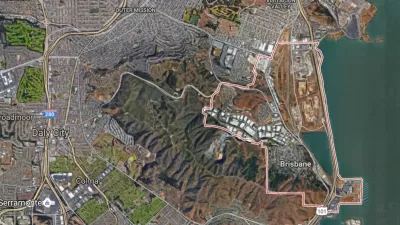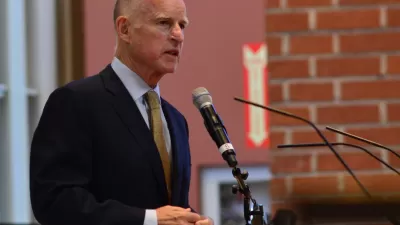Emissions from electricity generation are decreasing while those from transportation are increasing. If communities don't increase housing density to change travel patterns, it will only get worse, but the challenges may be insurmountable.

"While emissions from electrical plants fell in 2015, driven down partly by the rapid growth of large solar facilities, the amount of greenhouse gases spewed by cars and planes rose," reported David R. Baker for the San Francisco Chronicle in June on the California Greenhouse Gas Emission Inventory - 2017 Edition.
Illustrating why it is so difficult to reduce those transportation emissions, Liam Dillon reported for the Los Angeles Times on March 6 on the necessity to reduce driving in Southern California to meet climate goals, and the resistance by local communities to making the necessary land use changes that will change travel patterns.
“You can’t be pro-environment and anti-housing,” said Marlon Boarnet, chair of the Department of Urban Planning and Spatial Analysis at USC’s Price School of Public Policy, who has advised state climate regulators on land-use issues. “You can’t be anti-sprawl and anti-housing. This is something that has not been very well understood.”
The Southern California Association of Governments (SCAG), the metropolitan planning organization (MPO) for Los Angeles, Imperial, Orange, Riverside, San Bernardino and Ventura counties, has to prepare a regional transportation plan and sustainable communities strategy that shows how it will reduce greenhouse gas emissions resulting from transportation, as do the state's other 17 MPOs, according to SB 375, the Sustainable Communities and Climate Protection Act of 2008.
But those efforts haven’t been enough. In a series of reports over the last year, climate regulators have said California needed to reduce driving by an additional 15% over what regional governments have already planned to meet the 2030 greenhouse gas targets. That means even more closely packed housing than previously anticipated will be needed.
Hasan Ikhrata, SCAG's executive director, believes the new push to reduce driving is too difficult to achieve. “We’re going to do our best, but I think it’s too ambitious, to be honest with you,” Ikhrata said.
Of course, resistance to increased density is not restricted to Southern California. Reporting on July 28 from the small Bay Area city of Brisbane, population 4,700, just south of San Francisco in San Mateo County, Dillon describes the opposition to a development proposal located adjacent to a commuter rail station that could create a substantial dent in the region's housing crisis by providing 4,400 homes on 660 acres of vacant brownfield. But it's more than just local opposition to increased density that makes smart growth difficult in the Golden State.
The project, Brisbane Baylands, reveals how few incentives local governments have to accept large developments — even as the state is pushing to lower housing costs and funnel growth toward existing cities and nearby mass transit to combat climate change.
Under California’s tax system, Brisbane also earns more money if it rejects the current plan in favor of potential alternatives with more hotel rooms and space for businesses — but no homes.
While the "anti-development fervor" that has gripped Brisbane is the main focus of Dillon's piece, he also describes the challenges posed by the regulatory and economic framework that make smart growth so challenging in the state's coastal regions.
Hat tip to David McCoard.
FULL STORY: A Bay Area developer wants to build 4,400 sorely needed homes. Here's why it won't happen

Planetizen Federal Action Tracker
A weekly monitor of how Trump’s orders and actions are impacting planners and planning in America.

Congressman Proposes Bill to Rename DC Metro “Trump Train”
The Make Autorail Great Again Act would withhold federal funding to the system until the Washington Metropolitan Area Transit Authority (WMATA), rebrands as the Washington Metropolitan Authority for Greater Access (WMAGA).

The Simple Legislative Tool Transforming Vacant Downtowns
In California, Michigan and Georgia, an easy win is bringing dollars — and delight — back to city centers.

The States Losing Rural Delivery Rooms at an Alarming Pace
In some states, as few as 9% of rural hospitals still deliver babies. As a result, rising pre-term births, no adequate pre-term care and "harrowing" close calls are a growing reality.

The Small South Asian Republic Going all in on EVs
Thanks to one simple policy change less than five years ago, 65% of new cars in this Himalayan country are now electric.

DC Backpedals on Bike Lane Protection, Swaps Barriers for Paint
Citing aesthetic concerns, the city is removing the concrete barriers and flexposts that once separated Arizona Avenue cyclists from motor vehicles.
Urban Design for Planners 1: Software Tools
This six-course series explores essential urban design concepts using open source software and equips planners with the tools they need to participate fully in the urban design process.
Planning for Universal Design
Learn the tools for implementing Universal Design in planning regulations.
Smith Gee Studio
City of Charlotte
City of Camden Redevelopment Agency
City of Astoria
Transportation Research & Education Center (TREC) at Portland State University
US High Speed Rail Association
City of Camden Redevelopment Agency
Municipality of Princeton (NJ)





























